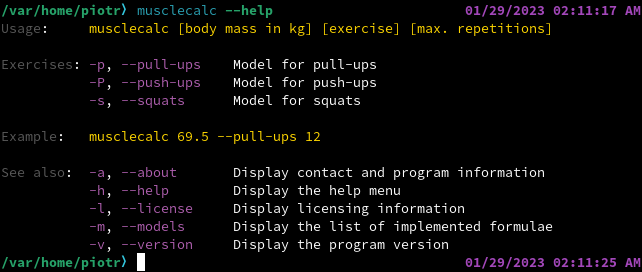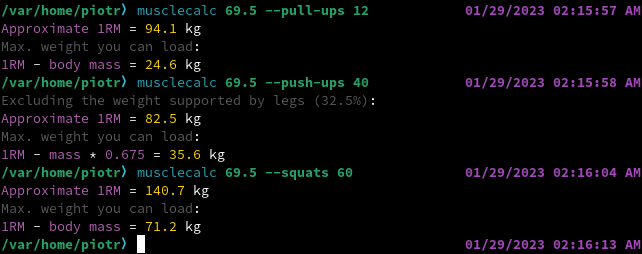
musclecalc employs mathematical formulae from Mayhew et al. (1992) and Wathen (1994) to estimate the maximum weight one can lift in a single repetition of a physical exercise (known as 1RM: one repetition maximum). Calculations are based on (1) the body mass, (2) the exercise type, and (3) the maximum number of repetitions one is able to perform in a single set without an additional weight i.e., with its own body mass.
[keywords: bodybuilding, calculator, calisthenics, callisthenics, fitness, gym, muscle strength, physical training, street workout]
musclecalc can be used by both females and males. Implemented models:
1. Pull-ups (including chin-ups, will also work fine for dips and other upper-body exercises lifting the whole body)
– Mayhew et al. (1992) equation is used as it appears to be more accurate for the upper body (LeSuer et al. 1997; Jiménez and De Paz 2008).
2. Push-ups (untested on females and dependent on the body form)
– Modified Mayhew et al. (1992) formula assuming that 32.5% of the body weight is supported on the ground by legs when push-ups are performed with a typical position of hands at the height of the chest.
3. Squats
– Wathen (1994) equation is used as it appears to be more accurate for the lower body (LeSuer et al. 1997).
References:
Jiménez, A. and De Paz, J.A. 2008. Application of the 1RM estimation formulas from the RM in bench press in a group of physically active middle-aged women. J. Hum. Sport Exerc. 3 (1): 10–22.
LeSuer, D.A, McCormick, J.H., Mayhew, J.L., Wasserstein, R.L. and Arnold, M.D. 1997. The accuracy of prediction equations for estimating 1-RM performance in the bench press, squat, and deadlift. J. Strength and Cond. Res. 11 (4): 211–213.
Mayhew, J.L., Ball, T.E., Arnold, M.D., and Bowen, J.C. 1992. Relative muscular endurance performance as a predictor of bench press strength in college men and women. J. Appl. Sports Sci. Res. 6 (4): 200–206.
Wathen, D. 1994. Load assignment. In: T.R. Baechle (Ed.), Essentials of strength training and conditioning, pp. 435–446. Champaign, IL: Human Kinetics.


musclecalc should run smoothly on Windows and macOS, and can be installed by the use of cargo. Yet, it is being developed and primarily tested on Fedora Linux.
musclecalc v0.2.3:
– Was successfully tested on Arch Linux, Fedora Linux 37, openSUSE Tumbleweed, Ubuntu 22.04 and Ubuntu 22.10.
– Failed to run on Mageia 8 due to an old glibc version (required ≥2.34).
[recommended for programmers]
1. Install from crates.io by the use of cargo:
cargo install musclecalc
By default, the file will be downloaded to .cargo/bin/, a hidden folder in your home directory.
2a. For convenience, you will probably want to copy musclecalc to /usr/bin/ as in Method 2 (3a, 3b).
2b. Alternatively, add ~/.cargo/bin directory to your PATH variable (can be set up by rustup).
1. Download the distro-independent binary of musclecalc from GitHub.
2. Make the file executable:
sudo chmod +x ./musclecalc
3a. On most Linux distros, install musclecalc via copying the binary to /usr/bin/:
sudo cp musclecalc /usr/bin/
3b. On Fedora Silverblue / Kinoite:
sudo cp musclecalc /var/usrlocal/bin/
[recommended for most users]
Distro-specific packages are also available for download for .rpm- and .deb-based Linux distros. Installation instructions:
Fedora Linux / RHEL / openSUSE:
sudo rpm -i musclecalc-0.2.3-1.x8664.rpm_
Fedora Silverblue / Kinoite:
rpm-ostree install musclecalc-0.2.3-1.x8664.rpm_
Ubuntu:
sudo dpkg -i musclecalc0.2.3amd64.deb
Download and unpack the musclecalc source from GitHub. Then, build and install the program:
cargo build --release && sudo cp target/release/musclecalc /usr/bin/